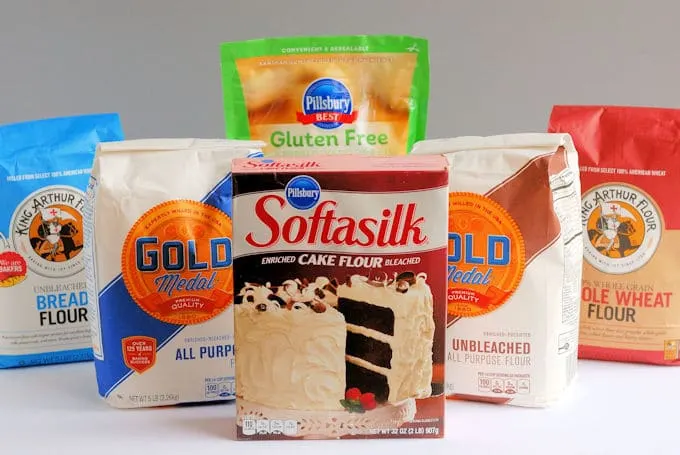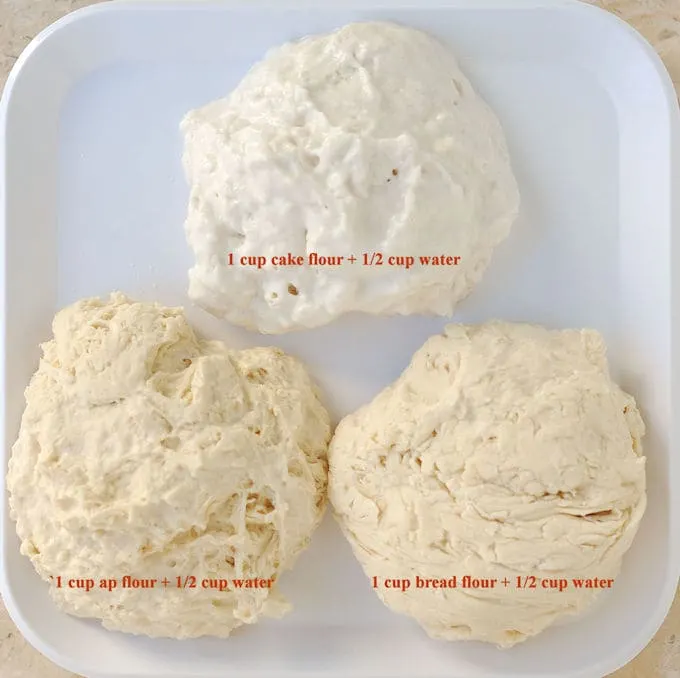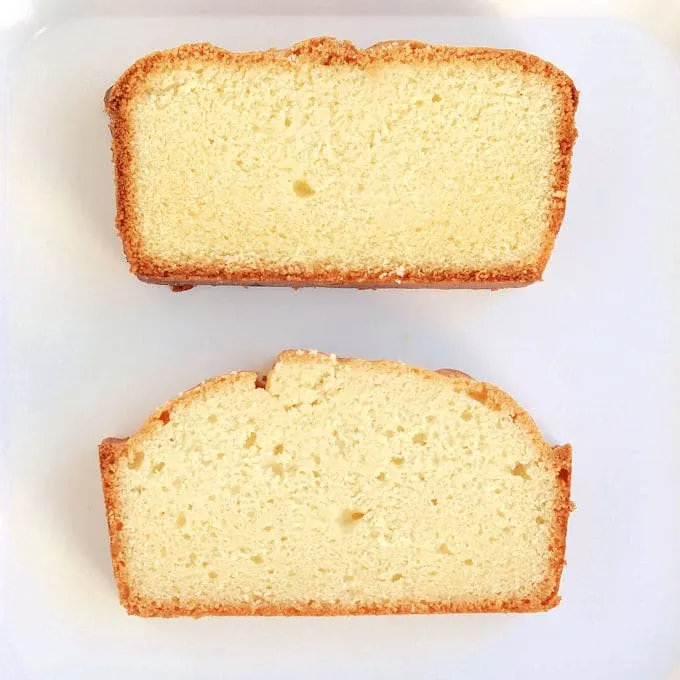Science of Flour in Baking
If there is one ingredient that defines baking, I would argue that it is flour. Specifically, wheat flour. Sure, sugar is important for desserts and pastries, but flour is the backbone of most baked goods.

The composition of Wheat Flour
Wheat flour is composed of proteins, starch, lipids, sugars and enzymes. The two most important of these components, the starch and the protein, form the “crumb” of a baked good. The crumb is a network of starch and protein interspersed with millions of tiny air bubbles.
Wheat flour is about 70% starch. Starch granules absorb water from the batter, swell up, and gel. As an item bakes, the gelled starch sets to help form the physical structure of the baked good.
Protein is the other major component of wheat flour. When a batter or dough is mixed, two proteins in the dry flour, glutenin and gliadin, absorb water and form gluten.
Gluten is a network of coiled and folded protein strands. The stronger the gluten, the more water it will absorb.
If you replace a low protein flour with an equal volume of high protein flour the batter will be much thicker, since the stronger gluten will absorb more of the available water.
Using a higher protein flour changes the outcome of the recipe not only because the gluten is tougher, but also because there is less water available to the other ingredients in the batter or dough.
The stronger the flour protein the more water it will absorb.

Why We Knead Dough:
As a batter or dough is mixed or kneaded the coiled and folded strands of gluten begin to align and tighten.
This is why a bread dough that starts out loose and “shaggy” becomes smooth and silky as it is kneaded. This is also why over-mixing batter will give you tough pancakes or a dense cake.
Types of Wheat Flour used in baking:
Hard wheat (often a “spring” wheat) is high in protein and low in starch. When this high protein wheat is milled, the hard kernels break into large chunks that will form a strong gluten network when they come in contact with water.
Soft wheat (often a “winter” wheat) has a lower protein content and higher starch content. When low protein wheat is milled, the soft kernels break into very fine particles. Winter wheat produces a fine and silky flour that forms a weak gluten network when it comes in contact with water.
- Bread flour contains more of the high protein wheat and cake flour contains more of the low protein wheat.
- All purpose flour is a mix of both types of wheat and has a medium protein content.
- Whole wheat flour is similar in protein content to all-purpose flour, but the bran and germ are left in the flour.
The Protein Content and Weight by Type of Flour:
Cake Flour is 7-8% protein and 1 cup weighs 4.5 oz
Bleached All Purpose Flour is 9.5-12% protein and 1 cup weighs 5 oz
Unbleached All Purpose Flour is 11-12% protein and 1 cup weighs 5 oz
Bread Flour is 12-13% protein and and 1 cup weighs 5 oz
Whole Wheat Flour is 11-15% protein and and 1 cup weighs 5 oz
When to use Bread flour vs. cake flour vs. all purpose flour
- Use bread flour when you want a tight and chewy crumb (bread or pizza).
- Use cake flour when you want a soft and tender crumb (pound cake).
- Use all purpose flour when you want an in-between texture (muffins or cookies).
What is Gluten-Free Flour?
Gluten-free recipes use non-wheat flours that don’t contain gluten. When using gluten-free flour, a binding agent must be added to the batter to replace the elasticity lost without the presence of the wheat flour protein.
I have used a commercial gluten-free flour which contains rice flour, potato starch, pea fiber, tapioca starch and xanthan gum. The xanthan gum acts as a binder to replace the structure provided by wheat gluten.
Without gluten the structure is weaker so a gluten-free baked good usually won’t rise as high as one made with wheat flour.



Thank you so much for your help!
Im doing a science fair project and I need to figure out which type of flour (bread, cake, pastry, or all-purpose) will give me the tallest/ largest (diameter) cookie. Do you know how the protein content/ other factors might affect this? Thanks!
The higher the protein content in a cookie, the higher it will rise but the less it will spread. Higher protein flour will also absorb more liquid, which reduces the spread of the cookies.
Both starch and protein absorb water, and presumably compete with each other in the flour to do so. But how would each affect the final texture of a dough that is cooked by frying (ie, like an Italian panzerotta)? If, for example, you wanted a softer, chewier final product, would it be better for the starch or the protein to absorb most of the water? Thanks
Well, if you want a chewier product I would use a flour with higher protein content, ap flour or bread flour. If you want a softer dough you can add some fat or sugar to the dough.
Thank you very much for this Information about flours în baking work.My questions îs how is the corelations betwin time of baking, temperature of baking, type of oven and type and qantity of leavenings. Thank you în advance.
I’m not sure how I can answer that question. Of course baking time is affected by temperature. I’m not sure about “type of oven”. 350F is 350F in any oven and every oven will be unique in that it may have hot spots or better or worse ventilation. You can read this post to learn more about leavenings.
@Eileen Gray,
Perhaps @Daniel means by different “types of ovens” different ovens such as direct-fired ovens, indirect-fired ovens, electric ovens, peel brick ovens,
rack ovens, among others. However the “question” is overly broad and sounds like he would benefit from just learning about how ovens work generally.
Some unbleached AP flours weigh different for a cup. King Arthur AP unbleached flour is 120 gm per cup. Since most recipes don’t specify brand of flour they are using, how do I know how much flour to use? Hope this makes sense!
I just published this article about how to measure baking ingredients.
Thank you so much for this plethora of information! I do have a few simple questions.
1. If I want to make a white cake, instead of using the yolks for the emulsifying agent, can I use high ratio shortening? If so, how much would I use in place of the yolks, in a single recipe?
2. Can I quadruple this recipe and expect the same results!
3. Does this recipe work for cupcakes, as well?
1. Here’s a recipe for white cake. The post has information about how I adapted a vanilla cake recipe to make a white cake. 2. Which recipe do you want to quadruple? 3. Which recipe?
Hi Eileen
In this post you show a picture of two Gluten free cakes with different mixing techniques. Which technique results in the higher rise? I seem to be having a lot of trouble getting my Gluten free cake to rise, despite reducing the sugar so perhaps it is the mixing technique?
I’d love your thoughts/advice!
Thanks!!
Normally I prefer to use the reverse creaming method to mix cake batter because less gluten formation means a more tender cake. Since that’s not a problem in a gluten free cake I found that the traditional creaming method worked better with gluten free flour to get a slightly lighter crumb. But I am by no means a gluten free expert.
Just wondering why you’re getting 5oz per cup for bread flour, which is a little more than 140gm. My reference is 120gm per cup.
Hi David, To measure a cup of flour I use the “dip and sweep” method. That means, I dip the cup into the flour bin, then sweep away the excess. I always get 5 oz of flour this way. If you use the method where you spoon the flour into the cup you can get less weight since there will more more air incorporated during the scooping process. The flour is “fluffier”. As long as you’re aware of the recipe writer’s method of volume measure you can adapt to that or, even better, use weight measure. This is exactly why most bakers will tell you that weight measure is the most accurate. Because there can be variation on how someone does volume measure.
Oh. you just blew my mind up -.- Now I have to do my research on local flours if I can find something similar to cake flour. (I guess I won’t find any)
Thanks, Xelita. Good luck with your research.
@Eileen Gray, I’m curious why you didn’t tell her how to substitute with cornstarch? Remove 2T./1 cup of AP flour and replace with cornstarch and the formation of the gluten is somewhat inhibited. The rest of your information is spot on.
I wish to make scones, can I use gluten free flour without adding anything else to the recipe?
Hi Lauri. I haven’t tried making my scones recipe with gluten free flour. I imagine they’ll bake up flatter than usual and will probably spread a bit. You’d have to play with the recipe a little to get it to work. Using gluten free flour I double you’ll be able to cut scones like a biscuit and have them rise up straight. I looked the the King Arthur flour website and they have a recipe for gluten free scones that uses gluten free flour plus extra xanthan gum. Good luck.
Thanks Eileen. I think I will try the recipe as is first since I haven’t made scones before. Happy rainy day to you!
Yes, it’s a very rainy day here.